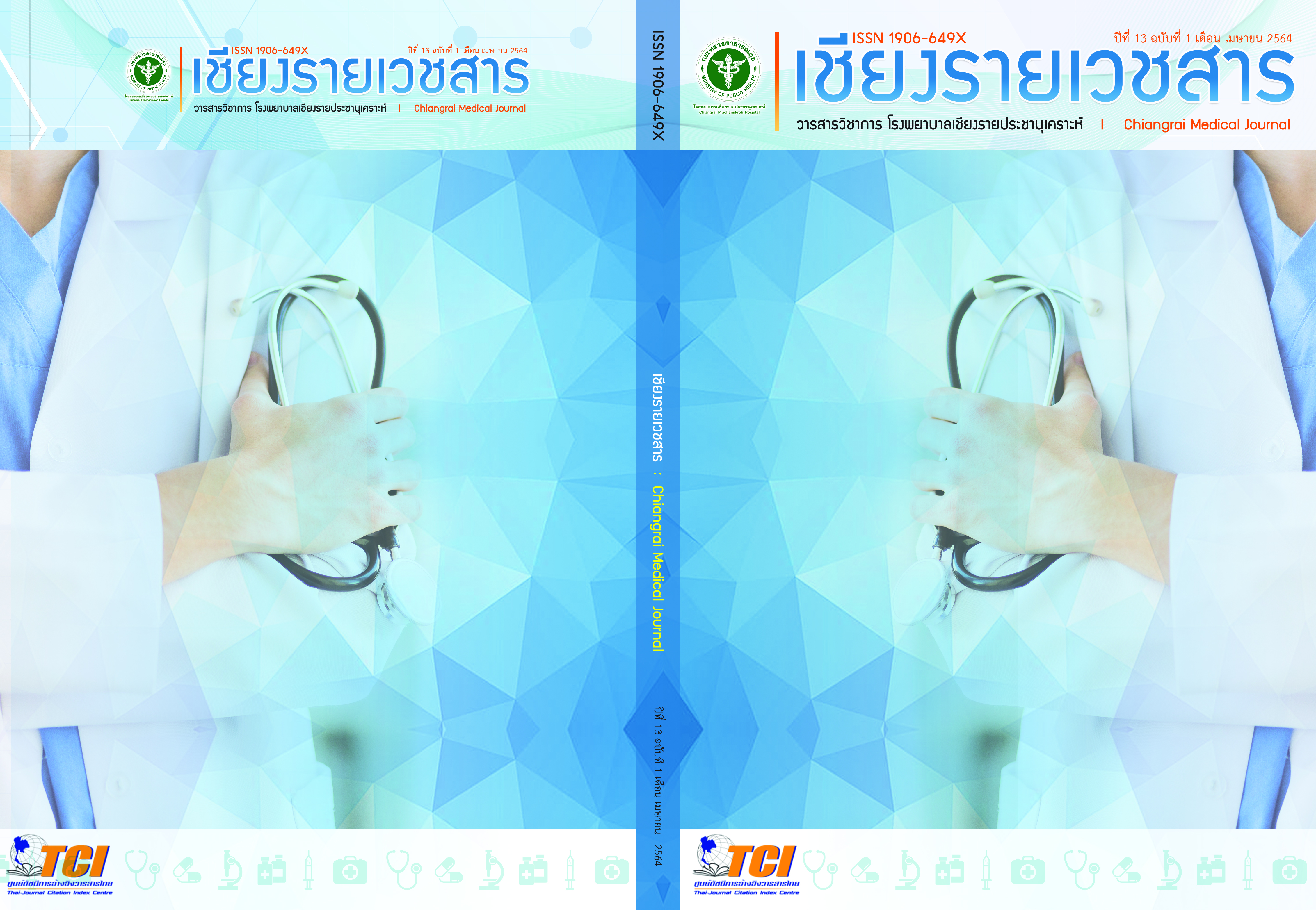ลักษณะที่มีความเสี่ยงต่อการเกิดภาวะเลือดออกในสมอง ในผู้บาดเจ็บที่ศีรษะเล็กน้อยที่กลับมารักษาซ้ำที่แผนกอุบัติเหตุฉุกเฉิน โรงพยาบาลนครพนม
Main Article Content
บทคัดย่อ
ความสำคัญ การบาดเจ็บที่ศีรษะ เป็นสาเหตุที่สำคัญของการเสียชีวิตและพิการในกลุ่มผู้บาดเจ็บของผู้บาดเจ็บจากอุบัติเหตุทุกประเภท ผู้บาดเจ็บที่ศีรษะ ระดับเล็กน้อยหรือมี GSC 13-15 (mild traumatic brain injury: mTBI) พบถึงร้อยละ 81 ซึ่งผู้บาดเจ็บกลุ่มนี้ มักไม่ถูกพิจารณาว่ามีภาวะเสี่ยงจากอาการสมองกระทบกระเทือน การศึกษานี้มีวัตถุประสงค์เพื่อศึกษาลักษณะเสี่ยงของผู้บาดเจ็บในกลุ่ม mild traumatic brain injury หรือ mTBI ที่กลับมารักษาซ้ำ (revisit) แล้วพบว่ามีภาวะเลือดออกในสมอง
วิธีการศึกษา เป็นการศึกษาเชิงสมุฏฐาน Retrospective case control (time matched) ที่งานอุบัติเหตุและฉุกเฉิน โรงพยาบาลนครพนม ในผู้บาดเจ็บ mTBI ที่กลับมา รักษาซ้ำ (revisit) พบมีเลือดออกในสมอง และเปรียบเทียบกับผู้บาดเจ็บที่จำหน่ายกลับบ้าน ในช่วงเดือนตุลาคม 2559 - กันยายน 2563 สืบค้นข้อมูลจากเวชระเบียน และฐานข้อมูลอิเลกโทรนิกส์ของโรงพยาบาล กลุ่มศึกษา case คือผู้บาดเจ็บ mTBI ที่กลับมา revisit แล้วพบว่ามีภาวะเลือดออกในสมองจำนวน 16 ราย เลือกกลุ่ม control ด้วย time-matched ที่จำหน่ายกลับบ้าน ในช่วงเวลาหน้าและหลังของ case จำนวน 5 รายรวม จำนวน 160 ราย วิเคราะห์ลักษณะทั่วไปด้วย t-test และ exact probability test หาความสัมพันธ์และลักษณะเสี่ยงต่อการเกิดภาวะเลือดออกในสมองในผู้บาดเจ็บ mild head injury ที่มา revisit ด้วย multivariable logistic regression
ผล ผู้บาดเจ็บ mTBI ที่กลับมา revisit มีเลือดออกในสมอง จำนวน 16 ราย มีอายุมากกว่า 60 ปี 8 ราย (50%) มีโรคประจำตัวมากกว่า 2 โรค 2 ราย (12.5%) ความดันโลหิตที่วัดได้ในวันเกิดเหตุมากกว่า140 mmHg สลบจำเหตุการณ์ไม่ได้ 4 ราย (25%) ไม่มีบาดแผลที่ศรีษะ 6 ราย (37.5%) และ มีประวัติดื่มแอลกอฮอล์หรือสารเสพติด 6 ราย ( 37.5%) พบว่าลักษณะเสี่ยงต่อการเกิดภาวะเลือดออกในสมองในผู้บาดเจ็บ mild head injury คือ อายุมากกว่า 60 ปี (aOR = 7.00, 95% CI, 2.36 – 20.74) และมีประวัติดื่มแอลกอฮอล์หรือสารเสพติด (aOR= 5.4, 95% CI, 1.73 – 16.82) อย่างมีนัยสำคัญทางสถิติ
สรุป ลักษณะที่มีความเสี่ยงต่อการเกิดภาวะเลือดออกในสมองในผู้บาดเจ็บ mTBI ที่กลับมาตรวจรักษาซ้ำ คือ อายุมากกว่า 60 ปี และมีประวัติดื่มแอลกอฮอล์หรือสารเสพติด ผู้บาดเจ็บที่มีลักษณะดังกล่าวจึงควรมีแนวทางในการดูแลรักษา และควบคุมการปฏิบัติอย่างเคร่งครัด เพื่อป้องกันความเสี่ยงจากการเกิดภาวะเลือดออกในสมอง
Article Details
เอกสารอ้างอิง
REFERENCES
Rubiano AM, Carney N, Chesnut R, Puyana JC. Global neurotrauma research challenges and opportunities.
Nature.2015;527:S193-7.
Kamal VK, Agrawal D, Pandey RM. Epidemiology, clinical characteristics and outcomes of traumatic brain injury:
evidences from integrated level 1 trauma center in India. J Neurosci Rural Pract. 2016;7:515-25
Dewan MC, Rattani A, Gupta S, Baticulon RE, Hung YC, Punchak M, et al. Estimating the global incidence of traumatic brain injury. J Neurosurg. 2018;1-18.
Nguyen R, Fiest KM, McChesney J, Kwon CS, Jette N, Frolkis AD, et al. The international incidence of traumatic brain injury: a systematic review and metaanalysis. Can J Neurol Sci. 2016;43(6):774–85.
Laptavee B, Mamom J. Factors predicting monitoring and preventive care of intracranial hemorrhage among mild head injury patients in Thammasat University Hospital. Thai Science and Technology Journal. 2015;23(6):1026.
Nipathakusolkit P, Nimitphan P, Songwathana P. Factors related to quality of life among traumatic brain injury
patients after discharged. Songklanagarind Journal of Nursing. 2015;35(1):135-52.
Komet O, Hirunchunha S, Sangchan H. Relationships of perceived susceptibility and perceived severity to intracranial hemorrhage monitoring in persons with mild traumatic brain injury and their caregivers. Thai Journal of Nursing Council. 2010;25(2):54-63.
Injury surveillance data collection, Nakhonphanom Hospital: Fiscal Year 2017 (October 2016 – July 2017). Nakhon Phanom: Nakhonphanom Hospital;2017.
National Association of Emergency Medical Technicians. PHTLS: prehospital trauma life support. 9th ed. Massachusetts:Jones & Bartlett Learning;2020.
Wong VS, Langley B. Epigenetic changes following traumatic brain injury and their implications for outcome, recovery and therapy. Neurosci Lett. 2016;625:26-33.
Bogstrand ST, Larsson M, Holtan A, Staff T, Vindenes V, Gjerde H. Associations between driving under the influence of alcohol or drugs, speeding and seatbelt use among fatally injured car drivers in Norway. Accid Anal Prev. 2015;78:14-9.
Boyd CR, Tolson MA, Copes WS. Evaluating trauma care: the TRISS method. Trauma score and the Injury Severity Score. J Trauma. 1987;27(4):370-8.
Rønning P, Helseth E, Skaga NO, Stavem K, Langmoen IA. The effect of ICP monitoring in severe traumatic brain injury: a propensity score-weighted and adjusted regression approach. J Neurosurg. 2018;31(6):1896-904.
Fotakopoulos G, Makris D, Tsianaka E, Kotlia P, Karakitsios P, Gatos C, et al. The value of the identification of predisposing factors for post-traumatic amnesia in management of mild traumatic brain injury. Brain Inj. 2018;32(5):563-68.


